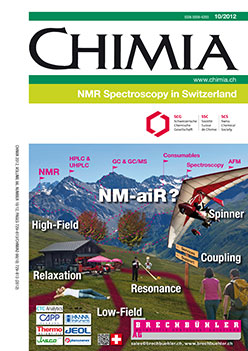Approaches towards Structures of Y Receptors, Examples of Human G-Protein Coupled Receptors, by Solution NMR
Editorial
DOI:
https://doi.org/10.2533/chimia.2012.781Keywords:
Gpcr, Grafting, Ompa, Y receptorsAbstract
Despite recent advances no solution structure for a true G-protein coupled receptor (GPCR) is available today due to biochemical and spectroscopic problems. Herein we review our attempts to obtain assignments of GPCRs based on fragments comprising 2-3 transmembrane helices. The fragments are expressed in a heterologous system, and studied in detergent micelles using solution NMR spectroscopy. We report on the status of assignments of fragments from the Y4 receptor, a human GPCR. Assignments for the majority of the backbone resonances are available as well as sidechain assignments for the first two TM helices. Residues of TM4 are largely invisible. We review technical issues in preparing these samples and in the data analysis. In addition we developed an approach in which we have grafted the extracellular loops of the Y1 receptor onto a beta-barrel scaffold derived from the E. coli outer membrane protein OmpA. We could demonstrate that all loops can be successfully transferred, and that the resulting protein can be successfully refolded. The system is capable of recognizing the ligands from the neuropeptide Y family.Downloads
Published
2012-10-31
Issue
Section
Scientific Articles
License
Copyright (c) 2012 Swiss Chemical Society

This work is licensed under a Creative Commons Attribution-NonCommercial 4.0 International License.
How to Cite
[1]
Chimia 2012, 66, 781, DOI: 10.2533/chimia.2012.781.







